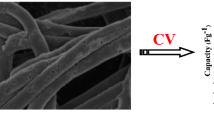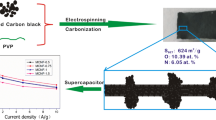Abstract
The porous carbon nanofiber mats were prepared by carbonization of electrospun polyacrylonitrile (PAN)/polymethylmethacrylate (PMMA) composite nanofibers and used as electrode materials for supercapacitor. The surface morphology and pore feature of the porous carbon nanofiber mats were characterized by scanning electron microscopy, transmission electron microscopy, Raman spectroscopy, powder X-ray diffraction, X-ray photoelectron spectroscopy, Fourier transform infrared spectroscopy and Brunauer–Emmett–Teller analysis. Cyclic voltammetry and chronopotentiogram methods were used to study the electrochemical properties of the porous carbon nanofiber mats as electrode materials for supercapacitor. Results showed that the porous carbon nanofiber mats had a good capacitance performance. The specific capacitance of the porous carbon nanofiber mats prepared at PAN/PMMA = 7:3 was 140.8 F g−1. At a current density of 10 A g−1, the specific capacitance of the porous carbon nanofiber mats prepared at PAN/PMMA = 7:3 only decreased by 4.6% after 10000 charge/discharge cycles. Therefore, the porous carbon nanofiber mats prepared at PAN/PMMA = 7:3 would be excellent electrode materials for use in supercapacitors.




Similar content being viewed by others
References
Simon P, Gogotsi Y (2008) Materials for electrochemical capacitors. Nat Mater 7:845–854
Simon P, Gogotsi Y, Dunn B (2014) Where do batteries end and supercapacitors begin? Science 343:1210–1211
He S, Chen W (2015) 3D graphene nanomaterials for binder-free supercapacitors: scientific design for enhanced performance. Nanoscale 7:6957–6990
Zhang Y, Zhang C, Huang G, Xing B, Duan Y (2015) Tailoring the textural properties of hierarchical porous carbons for supercapacitors. Mater Lett 159:377–380
He X, Li R, Han J, Yu M, Wu M (2013) Facile preparation of mesoporous carbons for supercapacitors by one-step microwave-assisted ZnCl2 activation. Mater Lett 94:158–160
Chu Y, Xiong S, Li B, Qian Y, Xi B (2016) Designed formation of MnO2@NiO/NiMoO4 nanowires@nanosheets hierarchical structures with enhanced pseudocapacitive properties. ChemElectroChem 3:1347–1353
Dong Y, Wang W, Quan H, Huang Z, Chen D, Guo L (2016) Nitrogen-doped foam-like carbon plate consisting of carbon tubes as high-performance electrode materials for supercapacitors. ChemElectroChem 3:814–821
Gao S, He S, Zang P, Dang L, Shi F, Xu H, Liu Z, Lei Z (2016) Polyaniline nanorods grown on hollow carbon fibers as high-performance supercapacitor electrodes. ChemElectroChem 3:1–9
Gu S, Lou Z, Ma X, Shen G (2015) CuCo2O4 nanowires grown on a Ni wire for high-performance, flexible fiber supercapacitors. ChemElectroChem 2:1042–1047
Kang X, Wang C, Yin J (2017) Hierarchically porous carbons derived from cotton stalks for high-performance supercapacitors. ChemElectroChem 4:1–10
Shi Z, Xing L, Liu Y, Gao Y, Liu J (2018) A porous biomass-based sandwich-structured Co3O4 @carbon fiber@Co3O4 composite for high-performance supercapacitors. Carbon 129:819–825
Nie G, Lu X, Chi M, Zhu Y, Yang Z, Song N, Wang C (2017) Hierarchical α-Fe2O3 @MnO2 core–shell nanotubes as electrode materials for high-performance supercapacitors. Electrochim Acta 231:36–43
Hao X, Wang J, Ding B, Chang Z, Wang Y, Dou H, Zhang X (2017) Nitrogen-doped porous carbon nanospheres from natural sepia ink: easy preparation and extraordinary capacitive performance. ChemNanoMat 3:895–901
Yu N, Yin H, Zhang W, Liu Y, Tang Z, Zhu MQ (2016) High-performance fiber-shaped all-solid-state asymmetric supercapacitors based on ultrathin MnO2 nanosheet/carbon fiber cathodes for wearable electronics. Adv Energy Mater 6:1501458
Tang H, Wang J, Yin H, Zhao H, Wang D, Tang Z (2015) Growth of polypyrrole ultrathin films on MoS2 monolayers as high-performance supercapacitor electrodes. Adv Mater 27:1117–1123
Zhang LL, Zhao XS (2009) Carbon-based materials as supercapacitor electrodes. Chem Soc Rev 38:2520–2531
Wang Z, Tan Y, Yang Y, Zhao X, Liu Y, Niu L, Tichnell B, Kong L, Kang L, Liu Z, Ran F (2018) Pomelo peels-derived porous activated carbon microsheets dual-doped with nitrogen and phosphorus for high performance electrochemical capacitors. J Power Sources 378:499–510
Dong YC, Son YJ, Ji MY, Jin SK, Ahn CY, Park S, Sung YE (2017) Coffee waste-derived hierarchical porous carbon as a highly active and durable electrocatalyst for electrochemical energy applications. ACS Appl Mater Interfaces 9:41303–41313
Zhang L, Jiang Y, Wang L, Zhang C, Liu S (2016) Hierarchical porous carbon nanofibers as binder-free electrode for high-performance supercapacitor. Electrochim Acta 196:189–196
Kim B-H, Yang KS, Ferraris JP (2012) Highly conductive, mesoporous carbon nanofiber web as electrode material for high-performance supercapacitors. Electrochim Acta 75:325–331
Xue-Qin LI, Chang L, Zhao SL, Hao CL, Chen-Guang LU, Zhu YH, Tang ZY (2017) Research on carbon-based electrode materials for supercapacitors. Acta Phys-Chim Sin 33:130–148
Li X, Hao C, Tang B, Wang Y, Liu M, Zhu Y, Lu C, Tang Z (2017) Supercapacitor electrode materials with hierarchically structured pores from carbonization of MWCNTs and ZIF-8 composites. Nanoscale 9:2178–2187
Agarwal S, Greiner A, Wendorff JH (2013) Functional materials by electrospinning of polymers. Prog Polym Sci 38:963–991
Su Z, Li J, Li Q, Ni T, Wei G (2012) Chain conformation, crystallization behavior, electrical and mechanical properties of electrospun polymer-carbon nanotube hybrid nanofibers with different orientations. Carbon 50:5605–5617
Zhang M, Zhao X, Zhang G, Wei G, Su Z (2017) Electrospinning design of functional nanostructures for biosensor applications. J Mater Chem B 5:1699–1711
Ma X, Xue M, Li F, Chen J, Chen D, Wang X, Pan F, Chen GF (2015) Gradual-order enhanced stability: a frozen section of electrospun nanofibers for energy storage. Nanoscale 7:8715–8719
Chan K, Choi YO, Lee WJ, Yang KS (2004) Supercapacitor performances of activated carbon fiber webs prepared by electrospinning of PMDA-ODA poly(amic acid) solutions. Electrochim Acta 50:883–887
Chan K (2005) Electrochemical characterization of electrospun activated carbon nanofibres as an electrode in supercapacitors. J Power Sources 142:382–388
Chen S, He S, Hou H (2013) Electrospinning technology for applications in supercapacitors. Curr Org Chem 71:1402–1410
Zeng Y, Li X, Jiang S, He S, Fang H, Hou H (2015) Free-standing mesoporous electrospun carbon nanofiber webs without activation and their electrochemical performance. Mater Lett 161:587–590
Duan G, Zhang H, Jiang S, Xie M, Peng X, Chen S, Hanif M, Hou H (2014) Modification of precursor polymer using co-polymerization: a good way to high performance electrospun carbon nanofiber bundles. Mater Lett 122:178–181
Zhang F, Yuan C, Zhu J, Wang J, Zhang X, Lou XW (2013) Flexible films derived from electrospun carbon nanofibers incorporated with Co3O4 hollow nanoparticles as self-supported electrodes for electrochemical capacitors. Adv Funct Mater 23:3944
Qiu Y, Li G, Hou Y, Pan Z, Li H, Li W, Liu M, Ye F, Yang X, Zhang Y (2015) Vertically aligned carbon nanotubes on carbon nanofibers: a hierarchical three-dimensional carbon nanostructure for high-energy flexible supercapacitors. Chem Mater 27:1194–1200
He S, Hu X, Chen S, Hu H, Hanif M, Hou H (2012) Needle-like polyaniline nanowires on graphite nanofibers: hierarchical micro/nano-architecture for high performance supercapacitors. J Mater Chem 22:5114–5120
He S, Chen L, Xie C, Hu H, Chen S, Hanif M, Hou H (2013) Supercapacitors based on 3D network of activated carbon nanowhiskers wrapped-on graphitized electrospun nanofibers. J Power Sources 243:880–886
Chen L, Zhu J (2014) Metal nanoparticle-directed NiCo2O4 nanostructure growth on carbon nanofibers with high capacitance. Chem Commun 50:8253–8256
Chan K, Park SH, Lee WJ, Yang KS (2004) Characteristics of supercapaitor electrodes of PBI-based carbon nanofiber web prepared by electrospinning. Electrochim Acta 50:877–881
Zhao H, Wang L, Jia D, Xia W, Li J, Guo Z (2014) Coal based activated carbon nanofibers prepared by electrospinning. J Mater Chem A 2:9338–9344
Guo Q, Zhou X, Li X, Chen S, Seema A, Greiner A, Hou H (2009) Supercapacitors based on hybrid carbon nanofibers containing multiwalled carbon nanotubes. J Mater Chem 19:2810–2816
Bonso J, Kalaw G, Ferraris J (2013) High surface area carbon nanofibers derived from electrospun PIM-1 for energy storage applications. J Mater Chem A 2:418–424
Abeykoon N, Bonso J, Ferraris J (2015) Supercapacitor performance of carbon nanofiber electrodes derived from immiscible PAN/PMMA polymer blends. RSC Adv 5:19865–19873
Singhal R, Kalra V (2014) Using common salt to impart pseudocapacitive functionalities to carbon nanofibers. J Mater Chem A 3:377–385
Niu H, Zhang J, Xie Z, Wang X, Lin T (2011) Preparation, structure and supercapacitance of bonded carbon nanofiber electrode materials. Carbon 49:2380–2388
Lai C, Zhou Z, Zhang L, Wang X, Zhou Q, Zhao Y, Wang Y, Wu XF, Zhu Z, Hao F (2014) Free-standing and mechanically flexible mats consisting of electrospun carbon nanofibers made from a natural product of alkali lignin as binder-free electrodes for high-performance supercapacitors. J Power Sources 247:134–141
Kim C, Ngoc BTN, Yang KS, Kojima M, Kim YA, Kim YJ, Endo M, Yang SC (2007) Self-sustained thin webs consisting of porous carbon nanofibers for supercapacitors via the electrospinning of polyacrylonitrile solutions containing zinc chloride. Adv Mater 19:2341–2346
Lu Y, Fu K, Zhang S, Li Y, Chen C, Zhu J, Yanilmaz M, Dirican M, Zhang X (2015) Centrifugal spinning: a novel approach to fabricate porous carbon fibers as binder-free electrodes for electric double-layer capacitors. J Power Sources 273:502–510
He H, Shi L, Fang Y, Li X, Song Q, Zhi L (2014) Mass production of multi-channeled porous carbon nanofibers and their application as binder-free electrodes for high-performance supercapacitors. Small 10:4671–4676
Acknowledgements
This work was financially supported by National Natural Science Foundation of China (21765009, 21565019 and 51563020), Department of Education Project of Jiangxi Province (GJJ151265), Engineering and Technology Research Center for Environmental Protection Materials and Equipment of Jiangxi Province (jxhbclyzb011), Graduate Innovation Fund of Jiangxi Normal University (YJS2017020) and the Open Project Program of Key Laboratory of Functional Small Organic Molecule, Ministry of Education, Jiangxi Normal University (Nos. KLFS-KF-201708, KLFS-KF-201713).
Author information
Authors and Affiliations
Corresponding author
Electronic supplementary material
Below is the link to the electronic supplementary material.
Rights and permissions
About this article
Cite this article
He, G., Song, Y., Chen, S. et al. Porous carbon nanofiber mats from electrospun polyacrylonitrile/polymethylmethacrylate composite nanofibers for supercapacitor electrode materials. J Mater Sci 53, 9721–9730 (2018). https://doi.org/10.1007/s10853-018-2277-5
Received:
Accepted:
Published:
Issue Date:
DOI: https://doi.org/10.1007/s10853-018-2277-5




